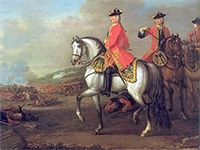King George II of Great Britain and Ireland
Part 2: On the Throne In 1737, King George's wife, Caroline, died, after complications with a surgery. He slept in a cot by her bed in her last days and underwent a period of intense mourning after she died. Great Britain became involved in a pair of wars as the 1730s became the 1740s. In 1739, Britain went to war with Spain in the War of Jenkins' Ear, so named because a British ship's captain named Robert Jenkins lost his ear in a skirmish. The following year, the much wider in scope War of Austrian Succession began. (A part of this conflict was fought in North America, between Britain and France, and was known there as King George's War.) In the political realm, the Prince of Wales became involved in the election of 1741, campaigning for the opposition to Prime Minister Robert Walpole. Frederick's influence was considerable, and Walpole's Whigs lost a considerable number of seats in Parliament. Walpole resigned the following year and was replaced by Spencer Compton. The king's most trusted adviser at this time was Lord Carteret. 
In 1743, George himself led troops into battle, at the Battle of Dettingen. (He is the last British monarch to do so.) The Austrian-British-Hanoverian alliance won that battle. Two years later, yet another Jacobite Rebellion occurred. This one sought to put Charles Edward Stuart, known as the Young Pretender and Bonnie Prince Charlie, on the throne. Charles was the son of James Stuart, the Old Pretender. The Jacobites won the Battle of Prestonpans in September 1745 but suffered a crushing defeat the following year, at the Battle of Culloden (April 16). The king's brother, William, Duke of Cumberland commanded the British forces, whose victory was so complete that the Young Pretender fled to France and never returned. The War of the Austrian Succession ended in 1748 with Britain's preferred results, Marie Therese recognized as Empress of Austria. Prince Frederick died in 1751 in London. His son George became heir to the throne. Yet another between Britain and France flared up in 1754, in North America. This was the French and Indian War. The war widened with a European theater and the entry of a handful of other countries in 1756, and this became the Seven Years War. (It wasn't called that at the time, however.) In 1757, George revoked a peace deal with France negotiated by his son. It was one of the few interests that he took in governmental matters in the last decade of his reign. Prime Minister William Pitt the Elder was the driving force behind the prosecution of the Seven Years War. Also at this time, Britain was asserting its influence in India, with troops under Sir Robert Clive winning key victories over France at Arcot and Plassey. George, by this time hard of hearing and bline in one eye, died on Oct. 25, 1760 of a heart attack. His grandson became King George III. Also during the reign of King George II:
First page > King-in-waiting > Page 1, 2 |
|
Social Studies for Kids
copyright 2002–2025
David White



 The new king sent for his oldest son and named him Prince of Wales and Earl of Chester. Frederick married August, the daughter of Frederick II, Duke of Saxe-Gotha-Altenburg, in 1736.
The new king sent for his oldest son and named him Prince of Wales and Earl of Chester. Frederick married August, the daughter of Frederick II, Duke of Saxe-Gotha-Altenburg, in 1736.
